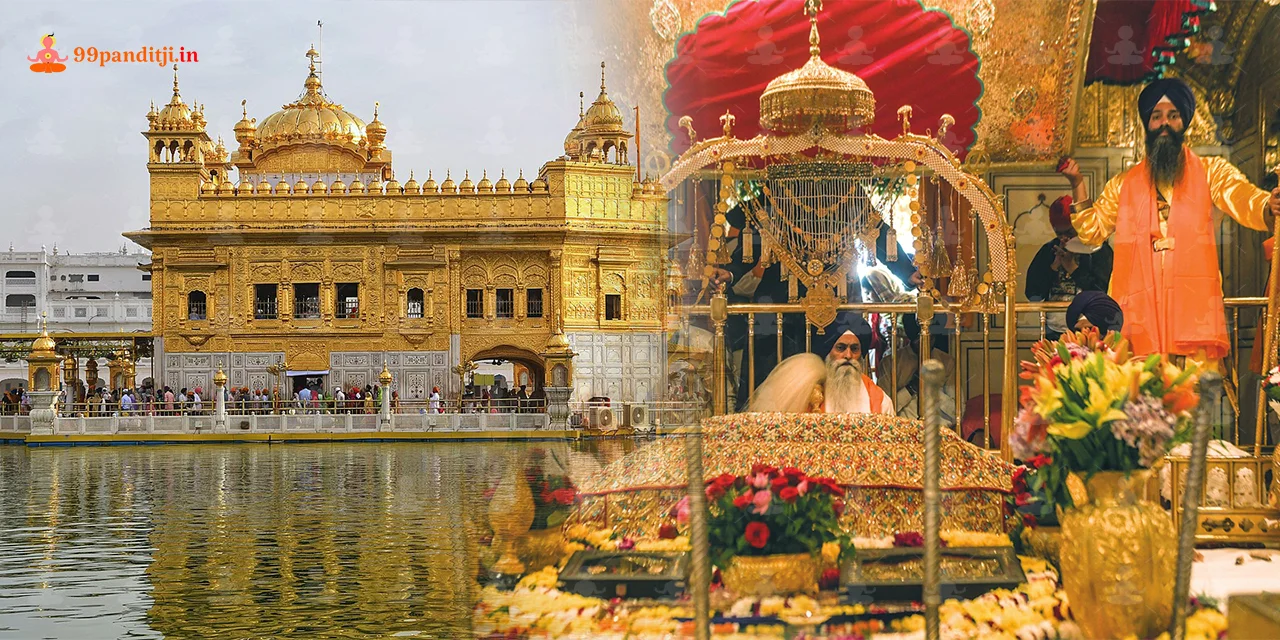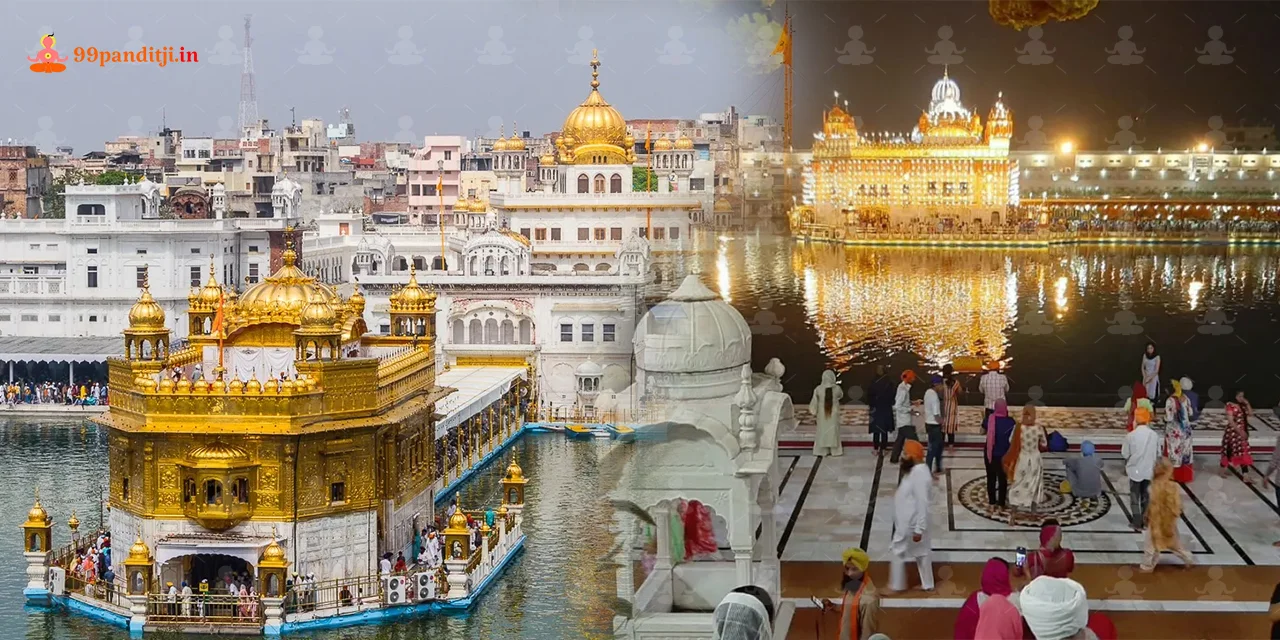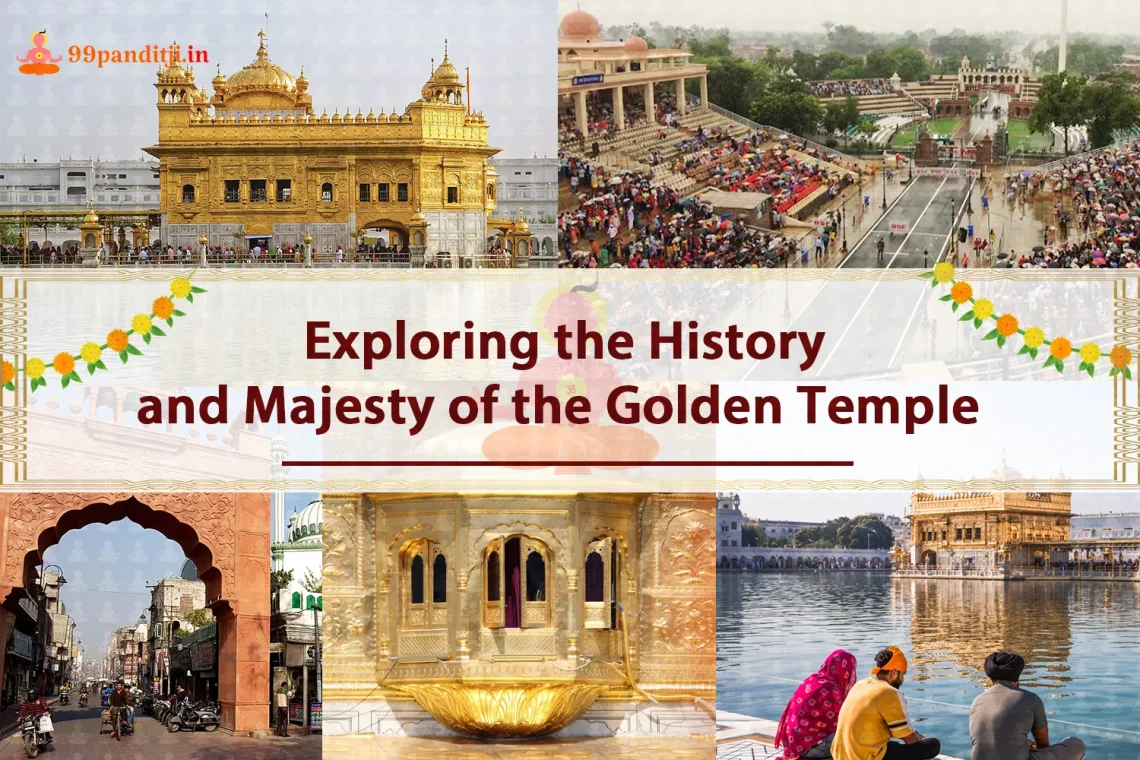The Golden Temple in Amritsar is one of the important architectural marvels. This Temple has held the eyes and awe of many generations across the globe. This magnificent temple is the majestic architectural place of worship in India known as the Golden Temple.
The Golden Temple is also known as the Harmandir Sahib. It is one of the major religious sites located in Amritsar, Punjab. It is considered one of the most revered spiritual sites in Sikhism. Millions of pilgrims and tourists from all over the world reach Amritsar to see this temple.
There is also a holy lake in the temple complex. The beautiful Golden Temple is situated in the middle of the lake. Before the Golden Temple was built, the first Sikh Guru Guru Nanak Dev Ji used to meditate here.

Devotees from all over the world come to the Golden Temple. Free Langar service is available in the Golden Temple. They serve Langar to the devotees here. They have covered this temple made of white marble with 24-carat gold, which is why they call it the Golden Temple.
History of the Golden Temple
The Golden Temple, also known as Darbar Sahib, was started in Amritsar in 1577 by the fourth Sikh Guru Guru Ram Das and was dedicated by the fifth Guru Arjan. Construction of the temple began in 1581, with the first version of the temple taking eight years to complete.
Guru Arjan planned to place the temple at a level somewhat lower than the city ground to emphasize humility before entering the complex. He also demanded that the temple complex be open on all sides, emphasizing that it was open to all.

In 1762, the invaders demolished the temple following a long-running dispute between Sikhs and Muslims. They completed a new main entrance, passage, and sanctum in 1776, while workers finished the pool work around the pond in 1784.
Ranjit Singh declared that he would rebuild it with marble and gold. The temple was renovated in marble and copper in 1809, and in 1830 Ranjit Singh donated gold to adorn the sanctum with gold plating.
Some people also believe that Guruji laid the foundation of this Gurudwara with the help of Mian Mir, a Sufi saint of Lahore, in December 1588.
Why is the Golden Temple sp revered?
After the construction of the Golden Temple, Guru Arjan installed the Adi Granth, which is the holy text of Sikhism. For Sikhs, it is considered to be the final, sovereign, and eternal living Guru after a lineage of ten human Gurus. It has 1,430 pages, and most of the content is divided into 31 ragas.

It accommodates the Akal Takht, which the Sikhs have termed as the ‘throne of the sixth guru’. The sixth guru, Guru Hargobind, designed it. Of the five high seats of Sikh power, the Akal Takht serves as the central location of political authority and a center where people can address the Sikh people’s religious and worldly problems.
Architectural Significance of the Golden Temple
The Golden Temple in Amritsar has a very unique architecture. This temple is famous for its blend of Hindu-Rajput and Indo-Islamic architecture. It is almost square and has a gold leaf dome. Here is some information to help you have a clear understanding of what the inside of the Golden Temple looks like, and its architectural significance:
1. Marble Path
The sanctum sanctorum within the Golden Temple features a marble platform. This platform is 19.7 x 19.7 meters square in measurement, inside a man-made pool sometimes referred to as Amrit Sarovar. The artisans decorate the elegant marble in the temple with floral motifs and animals. You can see almost the same architecture on the walls of the Taj Mahal in Agra too.
2. Holy Pool (Amrit Sarovar)
The pool within the Golden Temple in Amritsar is 5.1 meters deep. It is surrounded by a 3.7 meters-wide curved clockwise marble path. Many Sikhs believe that bathing in this Amrit Sarovar can help them purify their Karma and gain restorative powers. Some of them also take this holy water of Amrit Sarovar home for their sick friends and relatives.
3. Gold Leaf Dome
They have carved the upper half of the Golden Temple with gold leaf and panels, and topped it with a dome weighing about 400 kg of gold. Inside the Golden Temple, people can see priests chanting the Guru Granth Sahib throughout the day.
4. Akal Takht
Akal Takht is the supreme authority and one of the many primary seats of Sikhism, supervising the spiritual as well as secular elements. Founded by Guru Hargobind Ji, this Akal Takht lies directly opposite the main sanctum inside the Golden Temple.
5. Clock Tower
The Clock Tower was not in the original plan of the Golden Temple. In 1874, during the Second Anglo-Sikh War, the British added a clock tower after demolishing a part of the building. The Sikhs demolished the clock tower 70 years later and built a new entrance to the temple instead. However, this entrance has a clock facing north and people still call it Ghanta Ghar Deori.
Key facts about the Golden Temple, Amritsar
| Events / Categories | Description |
| Entry Fee | Free Entry |
| Festivals are celebrated | Baisakhi, Hola Mohalla, Guruparva |
| Best season to visit | October and March |
| Live Darshan | Available |
| Visitor Time | 05:00 AM to 10:00 PM |
| Address | Golden Temple Road, Atta Mandi, Katra Ahluwalia, Amritsar, Punjab 143006 |
Places to Visit near the Golden Temple Amritsar
After visiting the Golden Temple in Amritsar, there are several places to visit. If you want to visit then there are many historical sites in and around Amritsar where you can visit.
1. Jallianwala Bagh
Jallianwala Bagh is a place situated next to the Golden Temple. This place holds elevated historical significance and is the site of the Indian brave revolutionaries. On 13 April 1919, people peacefully protested against the Rowlatt Act and the release of two prominent nationalist leaders.
However, the British government opened fire on the unarmed public. In which thousands of people including women and children were martyred. The Government of India has now made it even better, where you will be able to know about this incident, one of the most miserable events in the history of our independence.
2. Durgiana Temple
Durgiana Temple is found in Amritsar itself. There is a beautiful lake inside this temple as well. People see Lord Vishnu’s and Goddess Lakshmi’s idols floating in this lake.

3. Attari-Wagah Border
The Attari-Wagah border of India and Pakistan is about 28 kilometers from Amritsar. It is really fascinating to see the Beating Retreat ceremony performed on the border here. Thousands of people come here to see it. You can also visit the parade here.

4. Hall Bazaar
If you have visited Amritsar and you want to shop then you can go to Hall Bazaar for shopping. Here you will find excellent books, beautiful jewelry, and electronic items along with excellent readymade clothes.

How to Reach the Golden Temple?
There are three ways to get to the Golden Temple: road, train, and air.
Air route- Amritsar has an international airport. Several modes of transportation are readily accessible from here to get to the Golden Temple.
By Road- Amritsar is located at a distance of about 500 km from Delhi. You can find buses to Amritsar from all major cities of the country.
Rail Route- Amritsar is connected to all major cities in India by rail. Numerous trains are available from Old Delhi and New Delhi to Amritsar. Rickshaws or taxis are accessible from Amritsar railway station to reach the Gurudwara.
Conclusion
In conclusion, the Golden Temple is not only a place of worship but also a living testament to the core values of Sikhism – compassion, humility, and service to humanity. The Temple, with its history, architecture, religious significance, Langar, tank, and Guru Granth Sahib, leaves an indelible mark on every visitor visiting this temple.

Sri Harmandir Sahib, famous as the Golden Temple, is one of the biggest attractions that draw people to Amritsar. Amritsar is also a spiritual center. It is the holiest Gurudwara of the Sikh faith. Guru Ramdas Sahib, the fourth of the 10 Sikh Gurus, built this Gurudwara and Sarovar in the 15th century when all people could pray.
They made many new improvements to the Gurudwara structure, such as paving marble on the ground.
Maharaja Ranjit Singh, who created the Sikh Empire of India (1799–1849), gilded the higher floor of the Gurdwara with 750 kilograms of pure gold.
Frequently Asked Questions
The Golden Temple, also known as Darbar Sahib, was started in Amritsar in 1577 by the fourth Sikh Guru Guru Ram Das, and was dedicated by the fifth Guru Arjan. Construction of the temple began in 1581, with the first version of the temple taking eight years to complete.
The construction of the Golden Temple was initiated by Guru Arjan Singh in 1581. The Golden Temple is also known as the Harmandir Sahib and Darbar Sahib.
The Golden Temple in Amritsar has a very unique architecture. This temple is famous for its blend of Hindu-Rajput and Indo-Islamic architecture.
The best time to visit the Golden Temple in Amritsar is October and March.
Maharaja Ranjit Singh, the creator of the Sikh Empire of India, reconstructed the Golden Temple. In 1809 it was rebuilt with marble and stone and in 1830 the sanctum was covered with gold leaf.
The outer part of the Golden Temple Gurudwara is made of gold, hence it is also known as the 'Golden Temple’.

